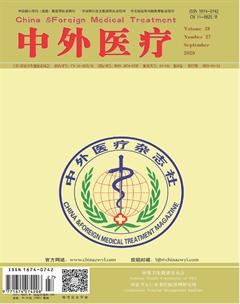PiCCO監測技術應用在感染性休克治療中的臨床指導作用分析
孟莉 林愛華 許可 徐大偉 張海潮


[摘要] 目的 探討PiCCO監測技術指導治療感染性休克的臨床價值。方法 便利選擇2016年1月—2019年12月該院重癥醫學科124例感染性休克病例,隨機分為實驗組(PiCCO監測參數指導臨床液體復蘇治療,63例)和對照組(CVP變化指導補液治療,61例)。比較觀察兩組干預前及干預24 h后液體復蘇相關指標及基該治療指標,統計救治成功率。結果 實驗組干預后尿量(0.44±0.07)mL/(kg·h),BLA(1.97±0.82)mmol/L,MAP(66.73±9.15)mmHg,ScvO2(69.58±9.13)%,PaO2/FiO2(286.42±30.13),液體總入量(2 875±360)mL,總液體復蘇時間(96.75±22.14)h,早期復蘇達標時間(5.2±1.9)h,機械通氣時間(90.36±11.54)h,ICU留置時間(7.86±2.05)d,救治成功率82.54%,各項指標均優于對照組,差異有統計學意義(t=3.295、3.776、4.512、4.380、6.871、9.551、7.219、3.726、8.514、3.956,χ2=4.803,P<0.05)。結論 PiCCO監測能夠準確反映血容量狀態,以此指導感染性休克液體復蘇治療效果確切,可以更好地改善患者心肺功能,同時避免過度輸液,有效提高救治成功率,促進早期康復。
[關鍵詞] 感染性休克;液體復蘇;PiCCO監測技術
[中圖分類號] R631? ? ? ? ? [文獻標識碼] A? ? ? ? ? [文章編號] 1674-0742(2020)09(c)-0062-03
[Abstract] Objective To explore the clinical value of PiCCO monitoring technology to guide the treatment of septic shock. Methods From January 2016 to December 2019, 124 cases of septic shock in the Department of Critical Care Medicine of the hospital were convenienty selected and randomly divided into experimental group (PiCCO monitoring parameters to guide clinical fluid resuscitation treatment, 63 cases) and control group (CVP changes guide fluid therapy, 61 cases). Comparing and observing the related indexes and basic treatment indexes of fluid resuscitation before intervention and 24 h after intervention in the two groups, and statistical treatment success rate. Results The urine output of the experimental group after intervention was (0.44±0.07) mL/(kg·h), BLA(1.97±0.82)mmol/L, MAP(66.73±9.15)mmHg, ScvO2(69.58±9.13)%, PaO2/FiO2(286.42±30.13), total amount of liquid (2 875±360)mL,total fluid resuscitation time (96.75±22.14)h, early resuscitation up to standard time (5.2±1.9)h, mechanical ventilation time (90.36±11.54)h, ICU indwelling time (7.86±2.05)d, treatment success rate 82.54%, all indicators were better than the control group, the difference was statistically significant(t=3.295,3.776,4.512,4.380,6.871,9.551,7.219,3.726,8.514,3.956,χ2=4.803,P<0.05). Conclusion PiCCO monitoring can accurately reflect the blood volume status, which can guide the exact effect of fluid resuscitation in septic shock, which can better improve the cardiopulmonary function of patients, while avoiding excessive fluid infusion, and effectively improve treatment success rate and early recovery.
[Key words] Septic shock; Fluid resuscitation; PiCCO monitoring technology
感染性休克指病原微生物及其毒素產物直接或間接引起微循環功能紊亂與組織灌注不足,導致細胞代謝與臟器功能障礙的循環衰竭綜合征,是重癥醫學科常見急危重癥[1]。該病多見于免疫功能低下、醫院內感染、大手術后及嚴重外傷者,病理病機復雜,致死率高,是ICU危重患者死亡主要原因。臨床救治該病,早期液體復蘇是關鍵,離不開有效的血流動力學監測為其提供依據和指導[2]。脈搏分析連續心排量監測(PiCCO)是基于經肺熱稀釋技術和脈搏波型輪廓分析計數發展而來的一種血流動力學參數監測與容量管理技術,具有精確、簡便、微創、高效費比的技術特點和優勢,可用以連續動態監測血流動力學變化,評估心臟收縮功能,為液體復蘇治療提供準確指導[3]。便利選擇于2016年1月—2019年12月該院124例感染性休克病例,分析探討PiCCO在該病臨床治療中的指導作用,現報道如下。

